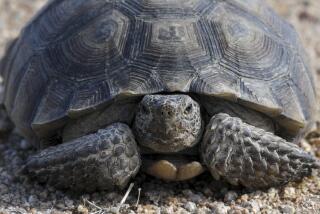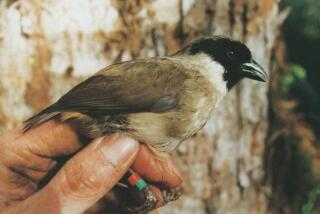U.S. declines to list the American pika as endangered
- Share via
The Obama administration Thursday declined to list the American pika as endangered, denying environmentalists’ contention that the tiny mountain-dwelling creature will be unable to survive climate change.
The rabbit-like mammal lives on the high slopes of California’s Sierra Nevada and in parts of nine other Western states. It is highly sensitive to small changes in temperature.
Larry Crist, a Utah field supervisor for the U.S. Fish and Wildlife Service, which reviewed scientific literature on the pika, said the creature can adapt and find suitable habitat despite a predicted summertime rise of 5.4 degrees Fahrenheit in the animal’s current range by 2050.
“We believe that in some low elevations pikas are likely to decline, but we see no danger of extinction through 2050,” Crist said, adding that there are no reliable estimates of the creature’s total population.
Shaye Wolf, a biologist with the Center for Biological Diversity, a Tucson-based nonprofit group, disputed the finding, saying that “scientific studies clearly show that the pika is disappearing from the American West due to climate change.”
A University of Nevada study in 2003 found that six of 25 pika populations in the Great Basin had disappeared because of rising temperatures.
Rising temperatures would shorten the period available for pikas to gather food, alter the plants they eat and shrink the insulating snowpack that protects them from cold snaps in the winter.
Because of their thick fur, higher summer temperatures can cause them to die of heat stroke, according to Wolf.
But the agency’s 71-page report on the pika noted that the creature tends to live in loose rock crevices below ground and is thus able to escape the heat in summer and gain insulation in winter.
The pika is thriving at low mountain elevations near Bodie, Calif., at California’s Lava Beds National Monument and at Idaho’s Craters of the Moon National Monument, it noted. There, pikas have altered their habits “to perform daily activities during the cooler morning and evening periods,” it said.
The center sued the agency in 2007 to force it to list the pika as endangered based on the threat of climate change. That could have provided leverage for efforts to force reductions in greenhouse gases from power plants, cars and factories, which are trapping heat in the atmosphere.
If listed, the pika would have been the second animal to gain federal protection because of climate change. After court battles, the Bush administration in 2008 listed the polar bear as a threatened species because of global warming that has melted ice in Arctic waters.
Last year, the Fish and Wildlife Service denied endangered status to the spotted seal, which environmentalists also view as threatened by melting Arctic ice.
More to Read
Sign up for Essential California
The most important California stories and recommendations in your inbox every morning.
You may occasionally receive promotional content from the Los Angeles Times.











